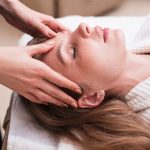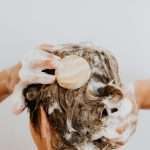Massaging your scalp is a great way to improve the overall health and appearance of your hair. But how often should you massage your scalp to get the best results? In this article, we’ll explore the answer to this question and discover the optimum frequency for scalp massage to achieve the best hair health.
Benefits of Scalp Massage
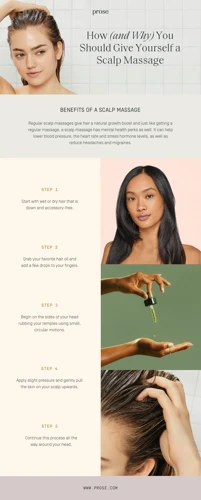
Scalp massage is a great way to promote overall hair health and growth. Massaging your scalp can boost circulation, help unclog and clear any blocked pores, and stimulate hair follicles. It can also help to relax the mind and reduce stress, which can help to avoid hair loss. Here are some of the benefits of scalp massage:
| Benefit | Explanation |
|---|---|
| Improves Circulation | Massaging your scalp improves blood circulation to the area and helps to bring more nutrients to the hair follicles. This increases the chances of hair growth and helps to keep hair looking healthy. |
| Stimulates Hair Follicles | Massaging your scalp can help to stimulate the hair follicles, which can help to promote new hair growth. It also helps to increase the strength of existing hair. |
| Relieves Stress | Massaging your scalp can help to relax the mind and reduce stress levels, which can help to prevent hair loss. It is also a great way to reduce stress-related headaches. |
| Reduces Scalp Tension | Massaging your scalp can help to reduce tension and tightness in the scalp, which can help to improve hair health and growth. It can also help to reduce scalp itching and flaking. |
In order to experience all the benefits of scalp massage, it is important to know how often you should massage your scalp for optimum hair health.
How Often Should You Massage Your Scalp?
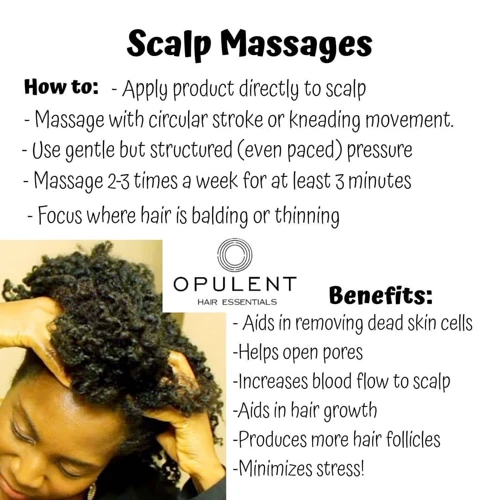
General Guidelines
Scalp massage is an excellent way to stimulate circulation and promote healthy hair growth. However, the frequency of scalp massages can vary according to individual needs. Ideally, scalp massage should be done at least once a week, but no more than three times a week.
For Hair Growth
If you’re looking to promote hair growth, then it’s best to do a scalp massage every other day. It is important to note that scalp massage should not be done too vigorously, as this can damage the scalp and cause irritation. To ensure maximum benefit, use a light touch and massage in circular motions.
With Oil
Using oil when performing a scalp massage can help to nourish the scalp and reduce dryness. Oils like coconut, jojoba, and argan oil are popular choices. For best results, apply a few drops of oil to the fingertips before massaging into the scalp. The massage should be done in small, circular motions for 5-10 minutes.
It is important to note that scalp massage is not a miracle cure for hair loss, but it can help to stimulate circulation and promote healthy hair growth. By using the right techniques and frequency, you can enjoy the benefits of scalp massage and keep your hair looking its best. So, how long does scalp massage work for hair? With regular use, you can enjoy the benefits of scalp massage for optimum hair health.
How Long Should a Scalp Massage Last?
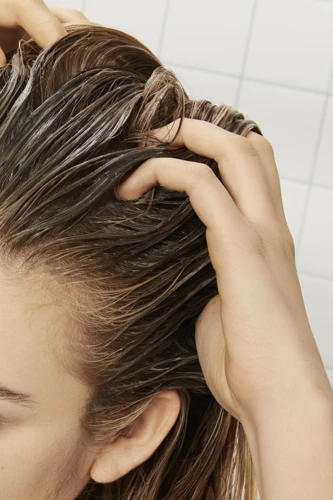
Scalp massages provide many benefits for the scalp, such as improving circulation and promoting relaxation. But how long should you massage your scalp for optimal results?
| Type of Scalp Massage | Length of Massage |
|---|---|
| General | 5-10 minutes |
| Deep Tissue | 15-20 minutes |
| Reflexology | 30-45 minutes |
For a general scalp massage, a 5-10 minute session should be enough to increase circulation and relax the scalp. For a deep tissue scalp massage, a longer session of 15-20 minutes will be necessary to reach the deeper layers of muscles and tissues. Lastly, for a reflexology scalp massage, a 30-45 minute session is required to hit all the reflex points in the scalp.
It’s important to note that the massage length depends on the individual. If you’re looking to promote relaxation, shorter massage sessions can be beneficial. But if you suffer from chronic pain and tension in your scalp, you may need longer sessions.
Always listen to your body and adjust the massage length accordingly. If you feel discomfort or pain at any point during your scalp massage, stop immediately and consult a medical professional if necessary.
How to Massage Your Scalp with Oil
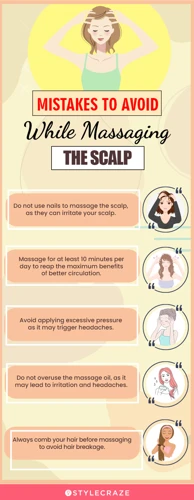
| Step | Instructions |
|---|---|
| 1 | Choose the right oil – not all oils are suitable for scalp massage. Look for natural oils such as coconut, avocado, argan, almond, and castor oils. |
| 2 | Warm up the oil – warm up the oil slightly before application. This will help the oil penetrate the scalp. |
| 3 | Massage the scalp – apply the oil to your scalp and massage it using your fingertips in circular motions. Make sure to cover your entire scalp, from the forehead to the nape of your neck. |
| 4 | Leave the oil on – leave the oil on your scalp for at least half an hour before washing it out. This will give the oil time to penetrate the scalp and nourish the hair follicles. |
| 5 | Wash out the oil – use a mild shampoo to wash out the oil. Don’t use too hot water, as this can strip the scalp of its natural oils. |
Regular scalp massage with oil can help improve hair health. How often you should massage your scalp with oil depends on your hair type and scalp condition. Generally, it’s best to massage your scalp with oil once a week. This can help improve blood circulation and moisturize your scalp and hair.
Which Oil is Best for Head Massage?

Head massage with oil can help to improve hair health by nourishing the scalp and hair follicles. Different oils have different benefits, so it’s important to think about which oil will best suit your needs.
Coconut oil is a popular choice for head massage, as it is naturally antibacterial and antifungal, making it great for removing any harmful bacteria from the scalp and unclogging pores. Coconut oil also helps to nourish the scalp and improve circulation.
Olive oil is another good option for scalp massage, as it contains antioxidants which can help to strengthen the hair and protect against breakage. It also helps to deeply moisturize and nourish the scalp.
Castor oil is another popular oil used in scalp massage. It is known to help promote hair growth, as it contains ricinoleic acid which helps to increase circulation to the scalp and reduce inflammation.
Almond oil is a light oil which helps to strengthen the hair. It is also known for its ability to help reduce dandruff and keep the scalp hydrated.
Jojoba oil is a natural moisturizer which helps to soothe the scalp and reduce any itching or flaking.
| Oil | Benefits |
|---|---|
| Coconut | Antibacterial, antifungal, nourishes scalp, improves circulation |
| Olive | Antioxidants, strengthens hair, moisturizes scalp |
| Castor | Promotes hair growth, increases circulation, reduces inflammation |
| Almond | Strengthens hair, reduces dandruff, keeps scalp hydrated |
| Jojoba | Natural moisturizer, soothes scalp, reduces itching and flaking |
When using oil for head massage, always use a small amount and massage it into the scalp in gentle, circular motions. This will also help to stimulate the scalp and promote healthy hair growth.
Precautions
- Always use oil: While massaging your scalp, use quality oil such as coconut, olive, or almond oil. This will help to nourish your scalp and ensure that your hair stays healthy.
- Be gentle: Avoid using too much pressure while massaging your scalp as it can lead to irritation and even breakage of your hair.
- Start slowly: If you are new to head massages, start with a gentle massage and gradually increase the pressure.
- Monitor your scalp: Pay close attention to your scalp during the massage and stop immediately if you experience any discomfort.
- Avoid too much heat: If you are using a heated oil for your massage, be sure to check the temperature before applying it to your scalp.
Frequently Asked Questions
What are the Benefits of Massaging the Scalp?
Stimulation of Blood Circulation: Massaging the scalp helps to stimulate blood circulation, which in turn helps to promote healthy hair growth.
Exfoliation: Massaging the scalp helps to remove dead skin cells, which can help to keep the scalp healthy and improve the overall appearance of the hair.
Relaxation: Massaging the scalp can help to reduce stress and promote relaxation, which can help to improve overall hair health.
Reduce Hair Loss: Massaging the scalp can help to reduce the risk of hair loss by improving the health of the follicles.
Improves Natural Oils: Massaging the scalp can help to improve the production of natural oils, which can help to moisturize the scalp and hair.
Is there a specific technique for massaging the scalp?
Yes, there are specific techniques for massaging the scalp. The most popular technique is called effleurage. This technique involves light, circular strokes with the fingertips, working from the middle of the scalp outward. This helps to loosen up any knots and stimulate circulation. Another popular technique is called tapotement. This involves tapping the scalp with the fingertips to help stimulate the scalp and promote circulation.
How often should I massage my scalp for the best results?
Daily: For optimum hair health, massaging the scalp daily is recommended. The massage should be gentle and focus on areas where the hair is thinning or balding.
Weekly: Weekly scalp massages are beneficial to improve circulation and stimulate hair growth. Massage the scalp in circular motions with your fingertips for several minutes.
Monthly: A monthly scalp massage can help reduce dandruff and remove excess dirt and oil from the scalp. Use a combination of essential oils, such as jojoba, coconut, and tea tree, to stimulate the scalp and promote healthy hair growth.
Seasonally: To keep your scalp and hair in top condition, give yourself a seasonal scalp massage. Use a combination of essential oils to soothe the scalp and help reduce stress.
Yearly: A yearly scalp massage is ideal for keeping your scalp and hair in top condition. Use a combination of natural oils and herbs to massage the scalp, such as rosemary and lavender.
Are there any potential side effects of scalp massages?
Yes. While scalp massages are generally considered safe, there are a few potential side effects to be aware of. These include:
- Headache: Scalp massages can cause headaches in some people, especially if they are done too aggressively.
- Mild soreness: Mild soreness around the scalp is common after a scalp massage. This is usually temporary and should go away in a few days.
- Skin irritation: If the massage is done too vigorously, it can lead to skin irritation or redness.
- Hair loss: It is very unlikely that a scalp massage will cause hair to fall out, but it can happen if the massage is too vigorous.
If you experience any of these side effects after a scalp massage, it is best to stop and seek medical advice.
Can scalp massages help with hair growth?
- Increases blood circulation: Scalp massages increase blood circulation to the hair follicles, promoting hair growth.
- Stimulates the scalp: Massaging your scalp stimulates the scalp and helps to loosen any build-up of dirt or oil.
- Reduces stress: Massaging your scalp can reduce stress, which is known to be linked to hair loss.
- Improves hair texture: Scalp massages can help to improve the texture of the hair, making it thicker and stronger.
Scalp massages are a great way to promote hair growth, as they help to increase blood circulation in the scalp, stimulate the scalp, reduce stress, and improve the texture of the hair. However, it is important to ensure that the massage is done correctly, as too much pressure can cause damage to the hair follicles.
Conclusion
Massaging your scalp regularly has many benefits for hair health, including improved blood circulation, stimulation of hair follicles for growth, and removal of product buildup. The frequency of scalp massages depends on individual hair needs, though ideally once or twice a week is recommended. With regular scalp massages, you can improve the health of your hair and keep it looking and feeling its best.



